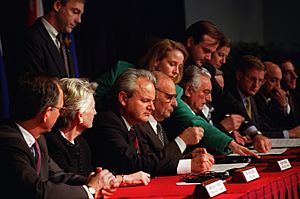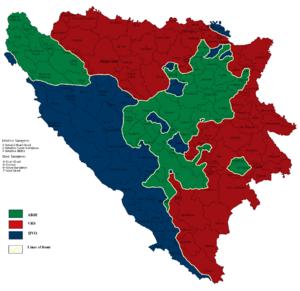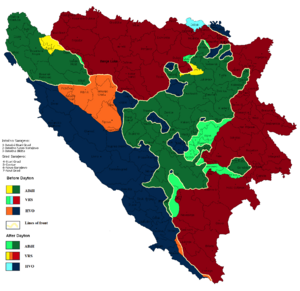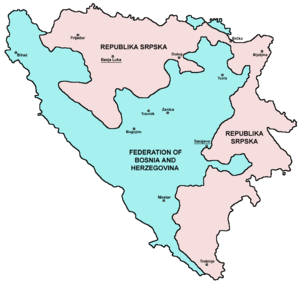Dayton Agreement facts for kids
| General Framework Agreement for Peace in Bosnia and Herzegovina | |
|---|---|

Seated from left to right: Slobodan Milošević, Alija Izetbegović, Franjo Tuđman initialling the Dayton Peace Accords at the Wright-Patterson Air Force Base on 21 November 1995.
|
|
| Drafted | 10 August 1995 |
| Signed | 14 December 1995 |
| Location | Wright-Patterson Air Force Base, Dayton, Ohio, U.S. |
| Signatories | |
| Parties |
|
| Language | English |
The General Framework Agreement for Peace in Bosnia and Herzegovina, also known as the Dayton Agreement or the Dayton Accords, is the peace agreement reached at Wright-Patterson Air Force Base near Dayton, Ohio, United States, on 21 November 1995, and formally signed in Paris, on 14 December 1995. These accords put an end to the three-and-a-half-year-long Bosnian War, which was part of the much larger Yugoslav Wars.
The warring parties agreed to peace and to a single sovereign state known as Bosnia and Herzegovina composed of two parts, the largely Serb-populated Republika Srpska and mainly Croat-Bosniak-populated Federation of Bosnia and Herzegovina.
The agreement has been criticized for creating ineffective and unwieldy political structures and entrenching the ethnic cleansing of the previous war.
Contents
Negotiation and signature
Though basic elements of the Dayton Agreement were proposed in international talks as early as 1992, these negotiations were initiated following the unsuccessful previous peace efforts and arrangements, the August 1995 Croatian military Operation Storm and its aftermath, the government military offensive against the Republika Srpska, conducted in parallel with NATO's Operation Deliberate Force. During September and October 1995, world powers (especially the United States and Russia), gathered in the Contact Group, pressured the leaders of the three sides to attend settlement negotiations; Dayton, Ohio was eventually chosen as the venue.
Talks began with an outline of key points presented by the U.S. in a team led by National Security Adviser Anthony Lake in visits to London, Bonn, Paris and other European stops 10 – 14 August 1995. These included Sochi, Crimea to consult Russian Foreign Minister Andrei Kozyrev. Lake's team handed off to a separate U.S. inter-agency group led by Assistant Secretary of State Richard Holbrooke, who went on to negotiate with Balkan leaders in their capitals. The Holbrooke crew conducted five rounds of intense shuttle diplomacy from August to October, including short conferences in Geneva and New York that resulted in the parties' adoption of principles for a settlement on 8 and 26 September respectively.
The Dayton conference took place from 1–21 November 1995. The main participants from the region were the President of the Republic of Serbia Slobodan Milošević (whom the Bosnian Serbs had previously empowered to represent their interests), President of Croatia Franjo Tuđman, and President of Bosnia and Herzegovina Alija Izetbegović with his Foreign Minister Muhamed Šaćirbeg.
The peace conference was led by US Secretary of State Warren Christopher, and negotiator Richard Holbrooke with two co-chairmen in the form of EU Special Representative Carl Bildt and the First Deputy Foreign Minister of Russia Igor Ivanov. A key participant in the US delegation was General Wesley Clark. The head of the UK's team was Pauline Neville-Jones, political director of the Foreign and Commonwealth Office. The UK military representative was Col Arundell David Leakey. Paul Williams, through the Public International Law & Policy Group (PILPG) served as legal counsel to the Bosnian Government delegation during the negotiations.
The secure site was chosen in order to remove all the parties from their comfort zone, without which they would have little incentive to negotiate; to reduce their ability to negotiate through the media; and to securely house over 800 staff and attendants. Curbing the participants' ability to negotiate via the media was a particularly important consideration. Richard Holbrooke wanted to prevent posturing through early leaks to the press.
After having been initialed in Dayton, Ohio, on 21 November 1995, the full and formal agreement was signed in Paris on 14 December 1995 and witnessed by Spanish Prime Minister Felipe González, French President Jacques Chirac, US President Bill Clinton, UK Prime Minister John Major, German Chancellor Helmut Kohl and Russian Prime Minister Viktor Chernomyrdin.
Content
The agreement's main purpose is to promote peace and stability in Bosnia and Herzegovina and to endorse regional balance in and around the former Yugoslavia (Article V, annex 1-B), thus in a regional perspective.
The present political divisions of Bosnia and Herzegovina and its structure of government were agreed upon, as part the constitution that makes up Annex 4 of the General Framework Agreement concluded at Dayton. A key component of this was the delineation of the Inter-Entity Boundary Line to which many of the tasks listed in the Annexes referred.
The State of Bosnia Herzegovina was set as of the Federation of Bosnia-Herzegovina and of the Republika Srpska. Bosnia and Herzegovina is a complete state, as opposed to a confederation; no entity or entities could ever be separated from Bosnia and Herzegovina unless by due legal process. Although highly decentralised in its entities, it would still retain a central government, with a rotating State Presidency, a central bank and a constitutional court.
The agreement mandated a wide range of international organizations to monitor, oversee and implement components of the agreement. The NATO-led IFOR (Implementation Force) was responsible for implementing military aspects of the agreement and deployed on 20 December 1995, taking over the forces of the UNPROFOR. The Office of the High Representative was charged with the task of civil implementation. The Organization for Security and Co-operation in Europe was charged with organising the first free elections in 1996.
Constitutional Court decision
On 13 October 1997, the Croatian 1861 Law Party and the Bosnia-Herzegovina 1861 Law Party requested the Constitutional Court of Bosnia and Herzegovina to annul several decisions and to confirm one decision of the Supreme Court of the Republic of Bosnia and Herzegovina and, more importantly, to review the constitutionality of the General Framework Agreement for Peace in Bosnia and Herzegovina since it was alleged that the agreement violated the Constitution of Bosnia and Herzegovina in a way that it undermined the integrity of the state and could cause the dissolution of Bosnia and Herzegovina. The Court reached the conclusion that it is not competent to decide the dispute in regards to the mentioned decisions since the applicants were not subjects that were identified in Article VI.3 (a) of the Constitution on those who can refer disputes to the Court.
It was one of the early cases in which the Court had to deal with the question of the legal nature of the Constitution. By making the remark in the manner of obiter dictum concerning the Annex IV (the Constitution) and the rest of the peace agreement, the Court actually "established the ground for legal unity" of the entire peace agreement, which further implied that all of the annexes are in the hierarchical equality. In later decisions the Court confirmed that by using other annexes of the peace agreement as a direct base for the analysis, not only in the context of systematic interpretation of the Annex IV. However, since the Court rejected the presented request of the appellants, it did not go into details concerning the controversial questions of the legality of the process in which the new Constitution (Annex IV) came to power and replaced the former Constitution of the Republic of Bosnia and Herzegovina. The Court used the same reasoning to dismiss the similar claim in a later case.
Territorial changes
Before the agreement, Bosnian Serbs controlled about 46% of Bosnia and Herzegovina (23,687 km2), Bosniaks 28% (14,505 km2) and Bosnian Croats 25% (12,937 km2).
Bosnian Serbs got large tracts of mountainous territories back (4% from Bosnian Croats and some small amounts from Bosniaks), but they had to surrender Sarajevo and some vital Eastern Bosnian/Herzegovian positions. Their percentage grew to 49% (48% by excluding the Brčko District, 24,526 km2).
Bosniaks got most of Sarajevo and some important positions in eastern Bosnia and Herzegovina while they lost only a few locations on Mount Ozren and in western Bosnia. Their percentage grew to 30%, and they greatly improved the quality of the land. Large tracts of prewar Bosniak (and Bosnian Croat) inhabited lands remained under Bosnian Serb control.
Bosnian Croats gave most (4% of BiH territories) back to the Bosnian Serbs (9% of today's RS) and also retreated from Una-Sana Donji Vakuf (in Central Bosnia) afterward. A small enlargement of Posavina (Odžak and parts of Domaljevac) did not change the fact that after Dayton Bosnian Croats controlled just 21% of Bosnia and Herzegovina (10,640 km2), compared to more than 25% prior to Dayton. One of the most important Bosnian Croat territories (Posavina with Bosanski Brod, Bosanski Šamac, Derventa) was left out of Bosnian Croat control.
Control of Republika Srpska
- About 89.5% (22,059 km2) was under control of Bosnian Serbs
- About 9% (2,117 km2) of today's territories of Republika Srpska was controlled by Bosnian Croat forces; mainly in municipalities of Šipovo, Petrovac, Istočni Drvar, Jezero, Kupres (RS) and part of Banja Luka municipality
- About 1.5% (350 km2) of today's territories of Republika Srpska was controlled by Bosniak forces, mainly some villages in Ozren (Doboj and Petrovo), western Bosnia (Krupa na Uni and parts of Novi Grad and Oštra Luka).
Control of Federation of Bosnia and Herzegovina
- About 53% (13,955 km2) of the Federation of Bosnia and Herzegovina was under Bosniak control.
- About 41% (10,720 km2) of the Federation of Bosnia and Herzegovina was under the control of Bosnian Croats.
- About 6% (1,435 km2) was under control of Bosnian Serbs.
See also
 In Spanish: Acuerdos de Dayton para niños
In Spanish: Acuerdos de Dayton para niños
- Washington Agreement
- Peace plans offered before and during the Bosnian War
- Proposed secession of Republika Srpska
- Constitutional reform in Bosnia and Herzegovina
- Erdut Agreement






